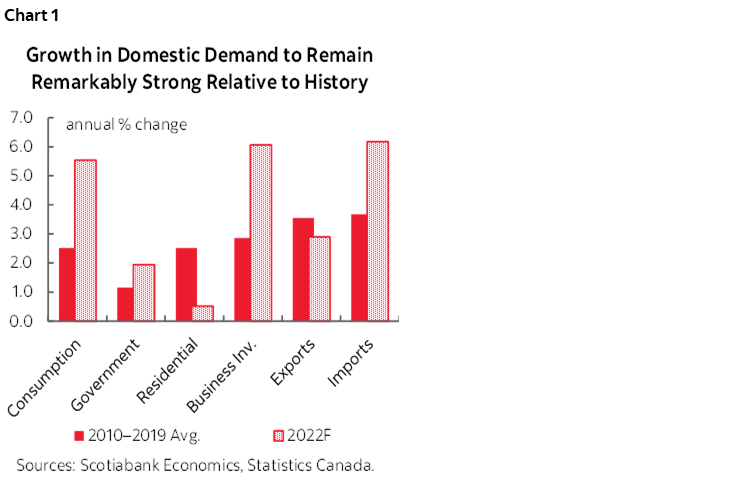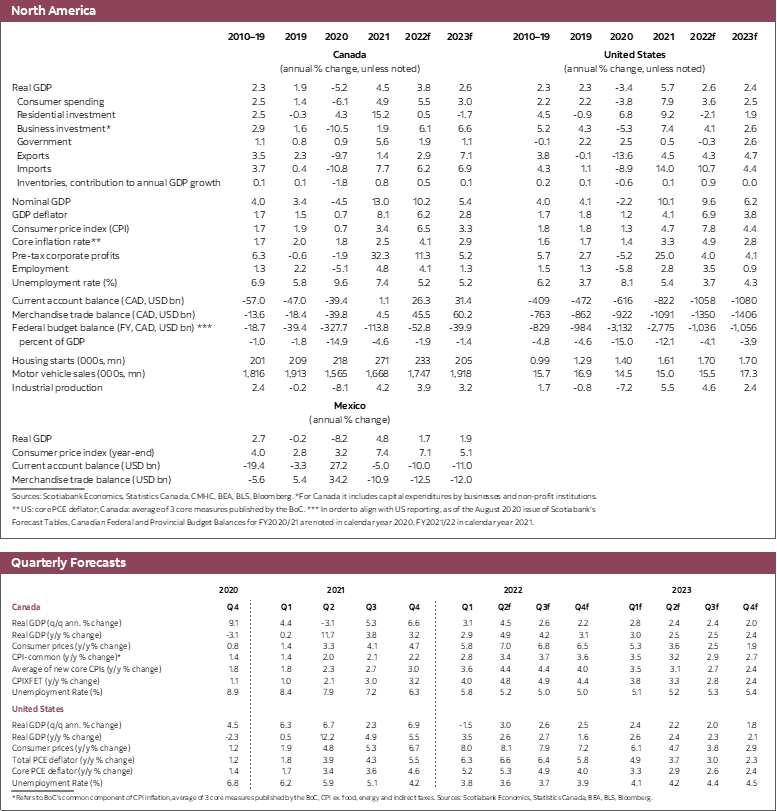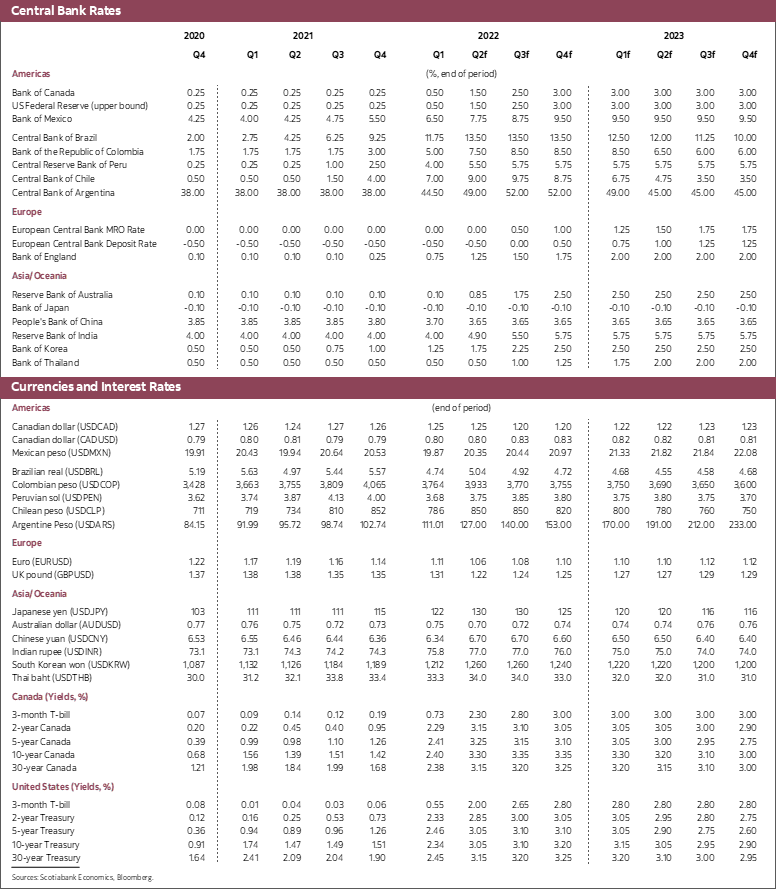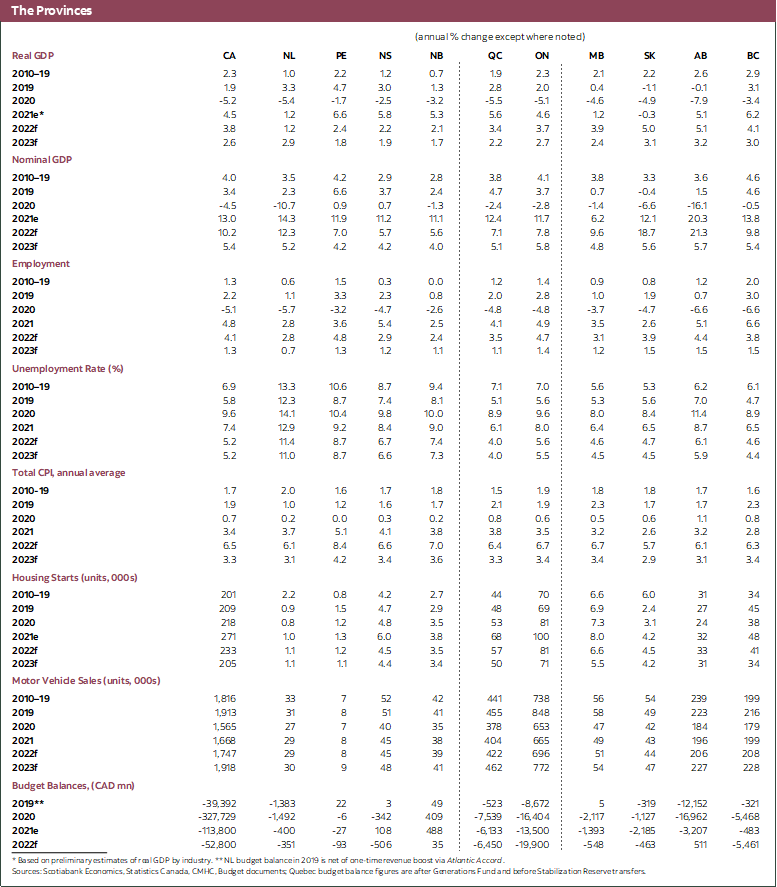- We continue to expect strong, above-potential growth in Canada this year even as interest rates and inflation slow the pace of economic expansion.
- Inflation remains problematically high, but we expect it to gradually slow in the second part of 2022 and through 2023 as the lagged impacts of input price increases on inflation fade. We forecast average inflation of 6.5% this year and 3.3% next year. If recent history is any guide, risks to that profile are likely tilted to the upside.
- The Bank of Canada is still in the early stages of a substantial series of policy rate increases this year. We predict a policy rate of 3.00% by the end of the year, double the current setting. The BoC should move in 50bps increments for at least the next two policy meetings. Given the upside risk to inflation, we believe risks are also tilted to the upside for the policy rate.
- Recession risks still appear low to us given the strength and breadth of factors driving Canadian growth, but those risks exist. Higher and more persistent inflation than currently forecast remains the most likely trigger for a recession in our view.
Recent developments suggest that only minor tweaks to the Canadian forecast are in order. While incoming economic data suggest the domestic economy remains strong, exports have been weaker than expected. Moreover, the decline in equity markets since our last forecast—largely associated with uncertainty about the global outlook and the expected rate path in the United States—is also contributing to a slightly weaker outlook than in our last forecast. Higher oil prices, which are on net a positive for Canada, are helping to counter some of these negative developments. Taken together, these revisions lead us to forecast growth of 3.8% in 2022 and 2.6% in 2023.
Imbedded in this view is continued strength in consumer spending as the economy is now fully re-opened and households re-engage in the broad range of activities that were commonplace pre-pandemic. This is, as expected, leading to a modest slowing in the consumption of goods in favour of services. The housing market is slowing as a result of the rise in interest rates. This is a most welcome development, but thus far the moderation of housing activity is largely in line with our prior expectations, so our forecast isn’t much impacted by these developments.
A major challenge on the business side remains labour shortages. While this, and the inflation outlook, have not yet led to large-scale increases in wages, we do anticipate a material acceleration in the pace of wage gains over the next year. In the meantime, we are seeing a pick-up in business investment given the still favourable economic situation, and of course the substantial increase in our terms of trade emanating from elevated commodity prices. That strength in business investment should continue for a number of quarters given the capacity constraints faced by firms at the moment.
Taken together, these factors continue to point to very strong growth this year. Most components of domestic demand are still expected to rise at a much more rapid pace than seen in the 10 years leading up to the pandemic (chart 1).

Inflation continues to remain well outside our and the Bank of Canada’s comfort zone. There are tentative indications that supply bottlenecks are becoming less binding, and we may well see a moderation in some goods prices as demand shifts to services, but input costs remain challenging for most firms. Moreover, the acceleration in food prices is likely to persist through the summer months, such that total inflation should only decline gradually as the year progresses. The Bank of Canada can do little in response to these developments given their largely exogenous nature, but there are signs that homegrown inflation will put upward pressure on inflation for the remainder of the year. This is already the case with rents, but we expect wages to rise and anticipate wage pressures will keep input costs elevated for firms. On balance, we forecast that inflation will average 6.5% this year and decline to 3.3% next year. As indicated above, the source of inflation should shift from largely foreign drivers to more domestic drivers as the year progresses. A worrisome development on the inflation front is the roughly 7% rise in unit labour costs in 2022-Q1. This, along with the economics community’s track record of underestimating inflationary pressures in recent quarters, suggest the risks to inflation may still be tilted to the upside.
Against this inflation background, we continue to believe the Bank of Canada must raise interest rates aggressively and expect it to move by 50bps at the next two meetings. We are sticking with our view that the policy rate will rise to 3.00% by the end of the year and remain there, but it seems clear that upside risks to the rate path are possible.
We continue to believe that the risks of recession remain low given the current strength of the outlook, but also because corporate and household balance sheets are strong, pent-up demand remains high, and the very large number of job vacancies likely means that employment will continue to grow even if the economy runs into a soft patch. There is, of course, a risk of a recession. In our view, this risk is principally linked to inflation outcomes; a material overshoot of our forecast for inflation in the second half of the year would raise the risk of recession significantly. Another risk is that the fear of recession actually triggers one: worries about gasoline and food prices, the state of global markets, and a potential recession in Europe can lead Canadian firms and households to be increasingly cautious, triggering a slowdown here.




DISCLAIMER
This report has been prepared by Scotiabank Economics as a resource for the clients of Scotiabank. Opinions, estimates and projections contained herein are our own as of the date hereof and are subject to change without notice. The information and opinions contained herein have been compiled or arrived at from sources believed reliable but no representation or warranty, express or implied, is made as to their accuracy or completeness. Neither Scotiabank nor any of its officers, directors, partners, employees or affiliates accepts any liability whatsoever for any direct or consequential loss arising from any use of this report or its contents.
These reports are provided to you for informational purposes only. This report is not, and is not constructed as, an offer to sell or solicitation of any offer to buy any financial instrument, nor shall this report be construed as an opinion as to whether you should enter into any swap or trading strategy involving a swap or any other transaction. The information contained in this report is not intended to be, and does not constitute, a recommendation of a swap or trading strategy involving a swap within the meaning of U.S. Commodity Futures Trading Commission Regulation 23.434 and Appendix A thereto. This material is not intended to be individually tailored to your needs or characteristics and should not be viewed as a “call to action” or suggestion that you enter into a swap or trading strategy involving a swap or any other transaction. Scotiabank may engage in transactions in a manner inconsistent with the views discussed this report and may have positions, or be in the process of acquiring or disposing of positions, referred to in this report.
Scotiabank, its affiliates and any of their respective officers, directors and employees may from time to time take positions in currencies, act as managers, co-managers or underwriters of a public offering or act as principals or agents, deal in, own or act as market makers or advisors, brokers or commercial and/or investment bankers in relation to securities or related derivatives. As a result of these actions, Scotiabank may receive remuneration. All Scotiabank products and services are subject to the terms of applicable agreements and local regulations. Officers, directors and employees of Scotiabank and its affiliates may serve as directors of corporations.
Any securities discussed in this report may not be suitable for all investors. Scotiabank recommends that investors independently evaluate any issuer and security discussed in this report, and consult with any advisors they deem necessary prior to making any investment.
This report and all information, opinions and conclusions contained in it are protected by copyright. This information may not be reproduced without the prior express written consent of Scotiabank.
™ Trademark of The Bank of Nova Scotia. Used under license, where applicable.
Scotiabank, together with “Global Banking and Markets”, is a marketing name for the global corporate and investment banking and capital markets businesses of The Bank of Nova Scotia and certain of its affiliates in the countries where they operate, including; Scotiabank Europe plc; Scotiabank (Ireland) Designated Activity Company; Scotiabank Inverlat S.A., Institución de Banca Múltiple, Grupo Financiero Scotiabank Inverlat, Scotia Inverlat Casa de Bolsa, S.A. de C.V., Grupo Financiero Scotiabank Inverlat, Scotia Inverlat Derivados S.A. de C.V. – all members of the Scotiabank group and authorized users of the Scotiabank mark. The Bank of Nova Scotia is incorporated in Canada with limited liability and is authorised and regulated by the Office of the Superintendent of Financial Institutions Canada. The Bank of Nova Scotia is authorized by the UK Prudential Regulation Authority and is subject to regulation by the UK Financial Conduct Authority and limited regulation by the UK Prudential Regulation Authority. Details about the extent of The Bank of Nova Scotia's regulation by the UK Prudential Regulation Authority are available from us on request. Scotiabank Europe plc is authorized by the UK Prudential Regulation Authority and regulated by the UK Financial Conduct Authority and the UK Prudential Regulation Authority.
Scotiabank Inverlat, S.A., Scotia Inverlat Casa de Bolsa, S.A. de C.V, Grupo Financiero Scotiabank Inverlat, and Scotia Inverlat Derivados, S.A. de C.V., are each authorized and regulated by the Mexican financial authorities.
Not all products and services are offered in all jurisdictions. Services described are available in jurisdictions where permitted by law.

